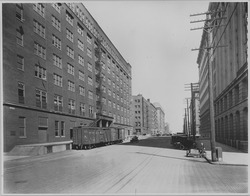Jobbers Canyon Historic District
|
Jobbers Canyon Historic District
|
|
|
Formerly listed on the U.S. National Register of Historic Places
|
|

A view of the canyon.
|
|
| Location | Farnam Street on the north, South Eighth Street on the east, Jackson Street on the south, and South Tenth Street on the west, Downtown Omaha, Nebraska |
|---|---|
| Built | 1920 |
| Architect | John Latenser; Et al. |
| Architectural style | Renaissance, Romanesque, Richardsonian Romanesque |
| NRHP reference # | 86003408 |
| Significant dates | |
| Added to NRHP | 1979 |
| Removed from NRHP | March 26, 2002 |
Jobbers Canyon Historic District was a large industrial and warehouse area comprising 24 buildings located in downtown Omaha, Nebraska, USA. It was roughly bound by Farnam Street on the north, South Eighth Street on the east, Jackson Street on the south, and South Tenth Street on the west. In 1989, all 24 buildings in Jobbers Canyon were demolished, representing the largest National Register historic district lost to date.
The development of Jobber's Canyon mirrored Omaha's emergence as a central hub in the United States transportation system of the late 19th century and early 20th century. As the "Gateway to the West" serving several historic trails the Canyon housed several warehouses, grocers, and other dry goods outfitters for merchants throughout the Old West, particularly those along the Great Platte River Road. Railroad entrepreneurs, land speculators, and merchants built Jobbers Canyon from the 1870s onward. After George Francis Train landed the Union Pacific and Credit Foncier of America in Omaha, the city quickly turned into a transportation hub. Fruit and vegetable wholesalers, meatpackers, and all sorts of supply people created a range of businesses, building almost 24 densely congested buildings in a seven-block by three-block area in downtown Omaha. At its peak, Jobbers Canyon had more than 1,700,000 square feet (160,000 m2) of office, warehouse, industrial and shipping space.
Speaking in 1987 about Jobber's Canyon, J. Jackson Walter, president of the National Trust for Historic Preservation said, "The warehouse district, to the best of my knowledge, is certainly one of the Middle West's or the nation's finest collection of this sort of buildings."
All of Omaha's largest and most notable wholesale and mercantile businesses built massive warehouse structures in the area by the early 20th century. Six and seven story red brick buildings filled with jobbing houses towered over red brick streets, creating a canyon-like feeling and leading to the area becoming called "Jobber's Canyon". The brick-surfaced South Ninth Street was an important streetscape in the city, with brick and cobblestone streets, railroad spur lines, loading docks, and dock canopies all contributing to the character of Jobbers Canyon.
...
Wikipedia
